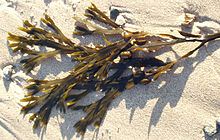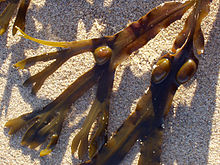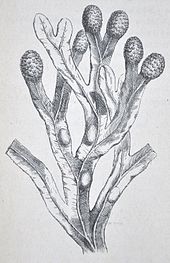- Fucus vesiculosus
-
Fucus vesiculosus 
Scientific classification Kingdom: Chromalveolata Phylum: Heterokontophyta Class: Phaeophyceae Order: Fucales Family: Fucaceae Genus: Fucus Species: F. vesiculosus Binomial name Fucus vesiculosus
L.Fucus vesiculosus, known by the common name bladder wrack or bladderwrack, is a seaweed found on the coasts of the North Sea, the western Baltic Sea, and the Atlantic and Pacific Oceans, also known by the common names black tang, rockweed, bladder fucus, sea oak, black tany, cut weed, dyers fucus, red fucus, and rock wrack. It was the original source of iodine, discovered in 1811, and was used extensively to treat goitre, a swelling of the thyroid gland related to iodine deficiency.
Contents
Description
The fronds of F. vesiculosus have a prominent midrib and almost spherical air bladders which are usually paired but may be absent in young plants. The margin is smooth and the frond is dichotomously branched. It is sometimes confused with Fucus spiralis with which it hybridizes.[1]
Distribution
Fucus vesiculosus is one of the most common algae on the shores of the British Isles.[2] It has been recorded from the Atlantic shores of Europe, Northern Russia, the Baltic Sea, Greenland, Azores, Canary Islands, Morocco and Madeira.[3][4] It is also found on the Atlantic coast of North America from Ellesmere Island, Hudson Bay to North Carolina.[5]
Ecology
The species is especially common on sheltered shores from the middle littoral to lower intertidal levels.[5] It is rare on exposed shores where any specimens may be short, stunted and without the air vesicles.[6] F. vesiculosus supports few colonial organisms but provides a canopy and shelter for the tube worm Spirorbis spirorbis, herbivorous isopods, such as Idotea and surface grazing snails such as Littorina obtusata.[1]
Biology
Plants of F. vesiculosus are dioecious. Gametes are generally released into the seawater under calm conditions and the eggs are fertilized externally to produce a zygote.[1] Eggs are fertilised shortly after being released from the receptacle. A study on the coast of Maine showed that there was 100% fertilisation at both exposed and sheltered sites.[1] Continuously submerged populations in the Baltic Sea are very responsive to turbulent conditions. High fertilisation success is achieved because the gametes are only released when water velocities are low.[7]
Consumption
Bladder wrack is used as an additive and flavouring in various food products in Europe. Bladder wrack is commonly found as a component of kelp tablets or powders used as nutritional supplements. It is sometimes loosely called "kelp", but that term technically refers to a different seaweed.
Primary chemical constituents of this plant include mucilage, algin, mannitol, beta-carotene, zeaxanthin, iodine, bromine, potassium, volatile oils, and many other minerals. The main use of bladder wrack (and other types of seaweed) in herbal medicine is as a source of iodine, an essential nutrient for the thyroid gland. Bladder wrack has proved most useful in the treatment of underactive thyroid glands (hypothyroidism) and goitre.[8]
Bladder wrack has been shown to help women with abnormal menstrual cycling patterns and/or menstrual-related disease histories.[9] Doses of 700 to 1400 mg/day were found to increase the menstrual cycle lengths, decrease the days of menstruation per cycle, and decrease the serum levels of 17B-estradiol while was later carried out and showed similar effects.[10]
Bladder wrack should not be used in cases of hyperthyroidism or cardiac problems, or during pregnancy and lactation. Excessive dosage (many times the recommended dosage) may lead to hyperthyroidism, tremor, increased pulse rate and elevated blood pressure.
See also
- Edible seaweed
- Sea wrack
- Seafood allergy
- Vitamin B12
References
- ^ a b c d Marine Life Information Network
- ^ F. G. Hardy & M. D. Guiry (2003). A Check-list and Atlas of the Seaweeds of Britain and Ireland. London: British Phycological Society. ISBN 0-9527115-1-6. http://seaweed.ucg.ie/check-list/check-list.pdf.
- ^ M. D. Guiry & Wendy Guiry (2007-01-12). "Fucus vesiculosus Linnaeus". AlgaeBase. http://www.algaebase.org/speciesdetail.lasso?species_id=87&sk=0&from=results.
- ^ Charlotta A. Nygård & Matthew J. Dring (2008). "Influence of salinity, temperature, dissolved inorganic carbon and nutrient concentration on the photosynthesis and growth of Fucus vesiculosus from the Baltic an Irish Seas". European Journal of Phycology 43 (3): 253–262. doi:10.1080/09670260802172627.
- ^ a b W. R. Taylor (1957). Marine Algae of the Northeastern Coast of North America. University of Michigan, Ann Arbor. ISBN 0-472-04904-6.
- ^ C. S. Lobban & P. J. Harrison (1994). Seaweed Ecology and Physiology. Cambridge University Press, Cambridge. ISBN 0-521-40897-0.
- ^ Serrao EA. Pearson GA, Kautsky L, Brawley SH (1996) Successful external fertilization in turbulent environments. Proc Natl Acad Sci USA 935286-5290
- ^ P. R. Bradley (1992). British Herbal Compendium. 1. Bournemouth, England: British Herbal Medicine Association. ISBN 0-903032-09-0.
- ^ Christine F. Skibola (August 2004). "The effect of Fucus vesiculosus, an edible brown seaweed, upon menstrual cycle length and hormonal status in three pre-menopausal women: a case report". BMC Complementary and Alternative Medicine 4: 10. doi:10.1186/1472-6882-4-10. PMC 514561. PMID 15294021. http://www.biomedcentral.com/1472-6882/4/10.
- ^ Christine F. Skibola, John D. Curry, Catherine VandeVoort, Alan Conley & Martyn T. Smith (February 2005). "Brown kelp modulates endocrine hormones in female sprague-dawley rats and in human luteinized granulosa cells". Journal of Nutrition 135 (2): 296–300. PMID 15671230. http://jn.nutrition.org/cgi/pmidlookup?view=long&pmid=15671230.
External links
External identifiers for Fucus vesiculosus EOL 893114 ITIS 11335 NCBI 49266 WoRMS 145548 Also found in: Wikispecies, MarLIN, AlgaeBase - F. Bunker. "Fucus vesiculosus Linnaeus Le Jolis". British Isles Seaweed Images. http://weedseen.co.uk/ShowSpecies.asp?id=ZR6760.
- M. D. Guiry. "Fucus vesiculosus Linnaeus". North Atlantic Seaweeds. http://www.seaweed.ie/descriptions/Fucus_vesiculosus.html.
- "Bladder wrack (Fucus vesiculosus)". ARKive. http://www.arkive.org/bladder-wrack/fucus-vesiculosus/.
Categories:- Fucales
- Edible algae
- Flora of Alaska
- Sea vegetables
Wikimedia Foundation. 2010.


